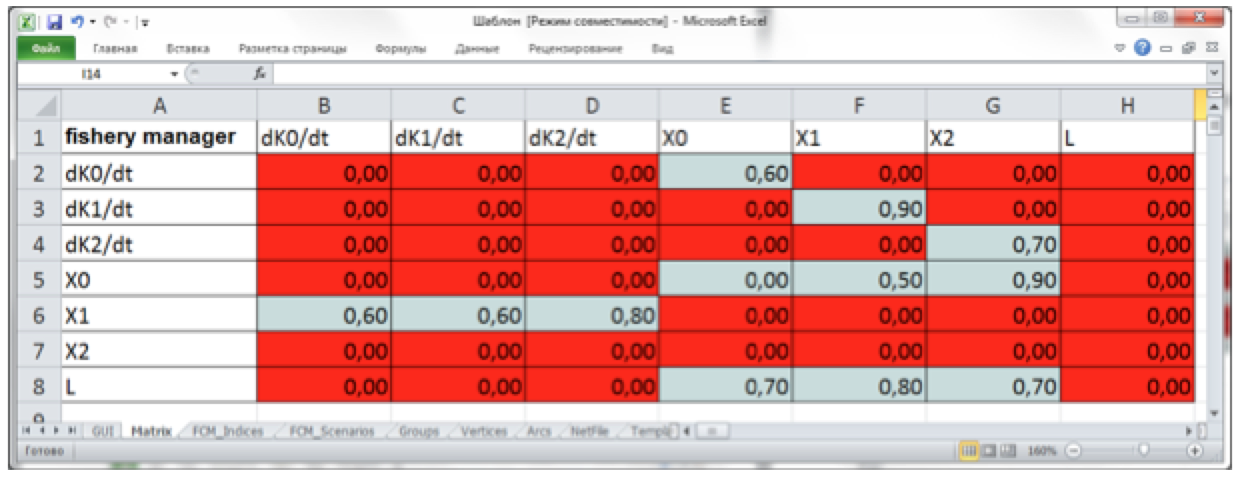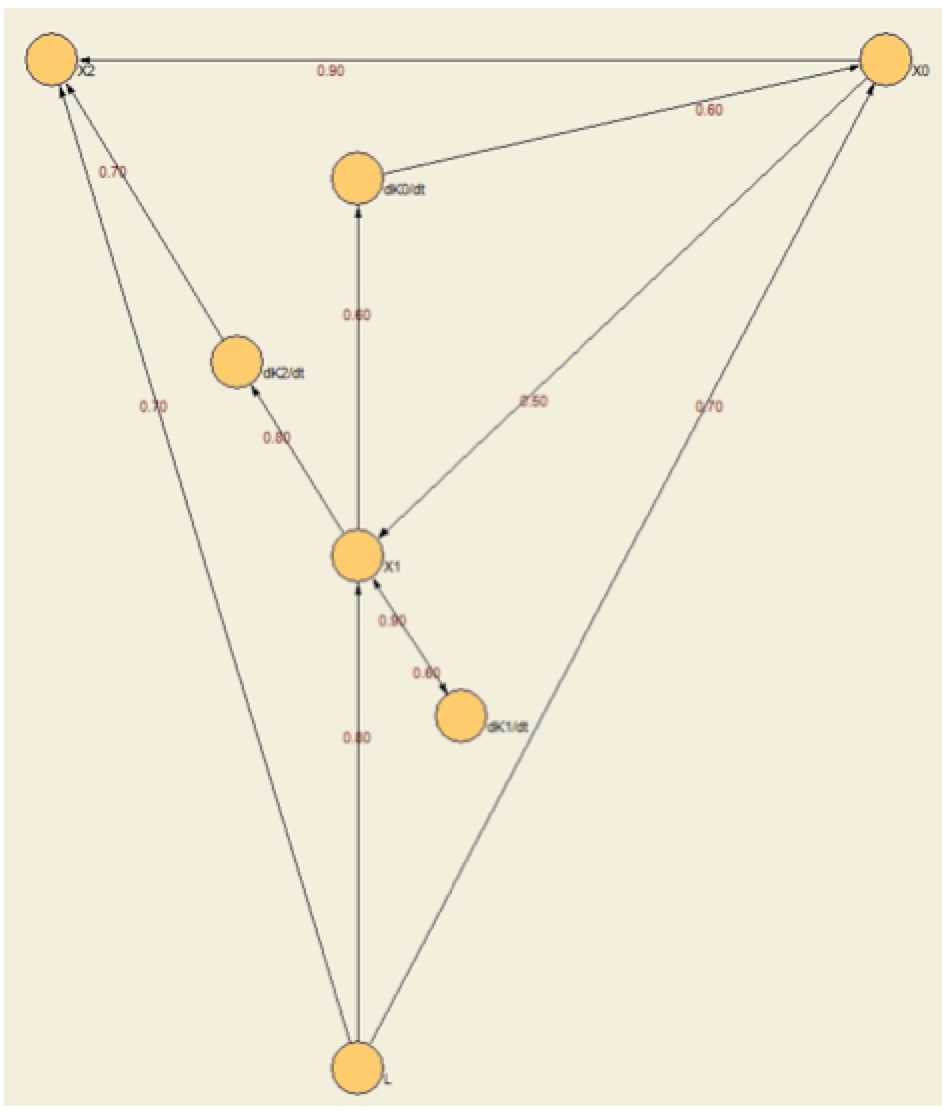

Vol. 38 (Nº 27) Año 2017. Pág. 4
Alexey Fruminovich ROGACHEV 1; Elena Valentonovna MELIKHOVA 2; Anna Vladimirovna SHOKHNEKH 3
Recibido: 16/12/16 • Aprobado: 14/01/2017
ABSTRACT: The article presents the information technology of cognitive modeling of industrial and investment self-development of medium-sized and single-industry towns that allows exploring specific processes of economic growth trends. Besides, the article presents 1) the adjacency matrix for cognitive map being developed; 2) a fragment of cognitive map of system’s self-development modeling. |
RESUMEN: Este artículo presenta la tecnología de la información del modelado cognitivo del desarrollo industrial y de inversión de ciudades medianas e individuales que permite explorar procesos específicos de tendencias de crecimiento económico. Además, el artículo presenta 1) la matriz de adyacencia para el mapa cognitivo que se está desarrollando; 2) un fragmento del mapa cognitivo del modelo de auto-desarrollo del sistema. Palabras clave: tecnología de la información, modelización cognitiva, modelización de dos niveles, auto-desarrollo industrial y de inversión, sistema de ciudades medianas e individuales, estructura de modelación cognitiva. |
Information technology of cognitive modeling of industrial and investment self-development of the system of medium-sized and single-industry towns ensures development and implementation of cognitive models that allows exploring specific processes (Rogachev A.F., 2013; Rogachev A.F., Melikhova E.V., 2014). For the urban development modeling of the towns of considered types we propose to create new technology consisting of two-level modeling. The lower level serves for fulfillment of cognitive model predicting in simplified form the general trends of urban development with account of redistribution of investment flows (Tokarev K.E., Shatyrko D.V., and Protsyuk, M.P., 2014).
The methodological basis of the research includes fundamental methods such as systematic, typological, structure-functional, and statistical analysis as well as mathematical economic modeling (Skiter N.N., Rogachev A.F., Shokhnekh A.V., Pleschenko T. V., 2014; Skiter N.N., Shokhnekh A.V., Melikhova E.V., 2015). We substantiated building a cognitive model at the lower level as a special method to justify the composition and interrelationships of the factors considered when developing mathematical economics methods of the upper level. Experimental studies are carried out based on materials of a typical medium-sized town (Volzhsky) and single-industry town (Mikhailovka) of the Volgograd Region. Analytical processing of the experimental data is carried out based on correlation and regression method using "Statistica 10" software, purchased with grant funds (Rogachev A.F., 2013; Rogachev A.F., Melikhova E.V., 2014).
Known analytical methods for dynamic modeling, based on mathematical models presented in the form of differential equations systems, involve main groups of factors and description of relationships between them, which are often linear and should be known (FCMapper http://www.fcmappers.net/joomla/; Rogachev, A.А., 2015). It was necessary to conduct preliminary fuzzy cognitive identification and assessment of the impact of such dominating factors and their relationships keeping in mind the features of the surrounding infrastructure. This approach to modeling the development dynamics of rural settlements and small towns taking into account investment flows can significantly reduce the amount of numerical experiments when constructing an adequate mathematical economic model (Tokarev K.E., Shatyrko D.V., Protsyuk M.P., 2014; Sahneh A.V., 2016).
Information technology of cognitive modeling of industrial and investment self-development system of medium-sized and single-industry towns includes 7 stages. Stages 1 and 2 of cognitive modeling are performed by professional knowledge engineers, stages 3, 5 and 7 are carried out by analysts, while stage 4 allows computer simulation using software such as specialized FCMapper tool (FCMapper, http://www.fcmappers.net/joomla/; Rogachev, A.F., 2015).
A sound group of enterprises (material, fund-creating and consumer) ensuring the functioning of the urban infrastructure and having different degree of influence on the economy was taken as the modeling object.
The numerical values of the degrees of causality relations, showing how one concept affects the other, are set by fuzzy cognitive map. When constructing the map, the experts use the following scale: strong impact (+1.0), regular impact (0.5), no impact (0.0), negative impact (-0.5) and strong negative impact (-1.0). In the case where the weights of causal relationships are extracted from data in the learning process of the obtained network, weights take random fuzzy values from the multitude {-1; 1}.
Based on the constructed fuzzy cognitive map we form matrices of mutual influences between concepts, followed by examination of the behavior and stability of the constructed map.
The mathematical apparatus of cognitive modeling includes:
a) modeling of self-development of a situation where the dynamics of the free motion of the state x(t) of the model is described by equation (1):
X(t) = (I + A + A2 + … + An)X(0), (1)
where I – is the identity matrix; A – is the adjacency matrix of size n x n; x(o) – are the initial conditions.
b) modeling of the controlled development of the system (2):
X(t+1) = P(0)·An (2)
where P(0) – is the pulse; A – is the adjacency matrix of size (n x n).
For the numerical implementation of the cognitive modeling procedure we construct the adjacency matrix reflecting the degree of mutual influence of the selected factors. A fragment of such matrix is presented in Fig. 1.

Fig. 1. Adjacency matrix to develop cognitive map.
The fragment of generated cognitive map of modeling the evolutionary self-development of economic system without taking into account the external control actions is presented in Fig. 2.
The effect of the total investments was taken as a criterion of conducted cognitive analysis of the modeled rural settlements and development of small towns. In the course of cognitive modeling we revealed the optimal distribution of investment flows between the main groups of enterprises.
It is planned to investigate the developed cognitive model in the following modes (Fig. 2):
- expert setting of the adjacency matrix elements;
- network training aimed at defining the set of coefficients of mutual influence of factors;
- study of the system’s self-development taking into account the updated values of the model parameters;
- study of the controlled development of the modeled system of flows interaction of the middle-sized town.

Fig. 2. A fragment of a cognitive map of the system’s self-development modeling.
Thus, the implementation of the developed algorithm of cognitive modeling will ensure the implementation of numerical simulation and identification of the factors that most significantly affect the economic performance of a simulated economic system of the middle-sized town, which takes into account investment flows and labor resources using appropriate linear or non-linear production functions (1).
To model urban development of the towns of considered types, we applied a new two-level modeling technology, in which the lower level serves for implementation of the cognitive model of the aggregate forecast of the general development trends of the towns in the system of income and redistribution of investment flows.
The results of the presented analysis will lay the basis for more stringent mathematical economic modeling of the development of small-sized and single-industry towns taking into account their specific differences, which are simulated by multivariate regression or analytical models that include differential equations and their systems.
This article was prepared at the financial support of the Russian Foundation for Basic Research and Administration of the Volgograd Region in the frameworks of the project "Formation of the conceptual strategy of industrial and investment development of medium-sized and single-industry towns with the use of two-level mathematical economic and cognitive modeling" No. 15-46-02543
1. Volgograd State Agrarian University, Russian Federation
2. Volgograd State Agrarian University, Russian Federation
3. Volgograd State Social-Pedagogical University, Russian Federation. Email: a.shokkh@bk.ru